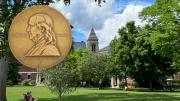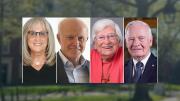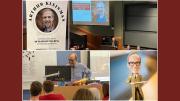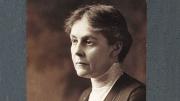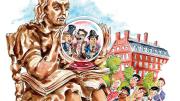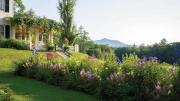Exploring Natural and Artificial Intelligence
Chan Zuckerberg Initiative founders Mark Zuckerberg ’06, L.L.D. ’17, and Priscilla Chan ’07 announced in December a $500-million gift to establish the Kempner Institute for the Study of Natural and Artificial Intelligence at Harvard. The institute, which will be based in the recently completed Science and Engineering Complex in Allston (see “A 500-Year Building,” January-February 2021, page 13), will be co-led by McKay professor of computer science Sham Kakade, formerly of the University of Washington, and Harvard Medical School’s Moorhead professor of neurobiology Bernardo Sabatini—a member of the school’s faculty since 2001, and a Howard Hughes Medical Institute Investigator since 2008. Kakade is an expert in the mathematical foundations of machine learning and artificial intelligence. Sabatini studies the mechanisms underlying synapse and circuit plasticity in living brains, which allow new behaviors to be learned and refined. The co-directors’ research thus embodies the institute’s mission, to seek fundamental principles that underlie both human and machine intelligence.
In an interview, Sabatini and Kakade said that their first priority will be to assemble an ecosystem of scientists and scholars, and then to define 10 grand challenges in the field of intelligence. Among the kinds of questions that might be pursued, explained Sabatini, is what happens when an artificial neural network is endowed with features from the human brain, such as a diversity of cell types, or with the type of neurons that researchers believe perform computation? Working the other direction, do theories about computation in artificial neural networks apply to biological intelligence?
The gift, which will be distributed during the next 15 years, will support 10 new faculty appointments, new computing infrastructure, and resources for students at all levels that will allow them to pursue knowledge across labs and disciplines. For a full report, see harvardmag.com/chan-ai-21.
—Jonathan Shaw
Seeing Allston Whole
As Harvard pursues ambitious development projects in Allston, residents fear that their neighborhood—“a blank canvas” and “the envy of any urban planner”—could end up looking like Boston’s Seaport district: a sterile landscape of laboratory buildings and luxury housing that skews wealthy and white.
As Harvard-related projects sweep from the river toward Central Allston, local stakeholders have been working with the University through the 15-member Harvard Allston Taskforce—an advisory body mediated by the Boston Planning and Development Association. But Taskforce members have expressed frustration with the process, because their input is sought one project at a time, and never as part of discussions about a vision for the whole of Allston, where Harvard owns 360 acres, one-third of the total land area.
The current trajectory of development-partner-fueled growth, in the commercially oriented Enterprise Research Campus and elsewhere (in contrast to Harvard’s pre-Great Recession plans for an academic campus, museum and arts facilities, and undergraduate and graduate housing) has left residents concerned about how their neighborhood will be further altered. It already faces diminished homeownership opportunities and a declining number of resident families. They also note that Harvard’s flurry of activity is attracting coattail developers, who need not coordinate among themselves or with the community to fashion a holistic vision for the area.
In a December letter to the Taskforce, Harvard president Lawrence S. Bacow wrote that he had asked the chief of University planning and design to address their concerns. “We are all committed to creating a district that the University and the community can be proud of,” Bacow stated. “We will continue to work collaboratively with the city, elected officials, and the Allston-Brighton community to further explore many of the important issues that we’ve heard about through the ongoing community-feedback process.” For a comprehensive report on the issues facing Allston, see harvardmag.com/allston-dev-21.
—Juliet Isselbacher
Shopping Week, R.I.P.?
Undergraduates have strongly expressed their support for “shopping week,” the traditional beginning of each term when they could visit classes, hear professors describe course aims and means, and then make up their schedules for the semester. But many faculty members, administrators, and graduate students loathe the practice because it impinges on instruction; complicates registration and makes the ultimate roster of students uncertain; and can result in mismatches between the available graduate teaching assistants and those needed to fulfill the requirements of many courses.
In March 2018, College dean Rakesh Khurana broached the idea of moving from shopping week toward a preregistration system with an add/drop provision (see “Undergraduate Education Agendas,” March-April 2019, page 22). Perhaps, some thought, digital tools could enable new, less disruptive ways of making course selections in advance, without moving toward full preregistration. Faculty of Arts and Sciences dean Claudine Gay and dean of undergraduate education Amanda Claybaugh, both seemingly supportive of preregistration, decided in the spring of 2019 that a committee ought to study the matter, taking note of the benefits of shopping—students assessing whether a course is a good fit, and taking intellectual risks to try something new; professors updating their syllabuses to keep them current—as well as the costs.
Now, the Committee on Course Registration has opted for what students will regard as the nuclear option: moving to a full preregistration system. This recommendation, issued in December (courseregistration.fas.harvard.edu), follows an interim period of experimenting with improvements in registration (see harvardmag.com/shopping-wk-19), followed by the pandemic-caused shift to a pre-term course review and registration period (necessitated during the 2020-2021 year of remote instruction, and continued this year—from January 12 through 20, for spring classes that began on January 24).
The 49-page final report, having considered fully “in-term” registration (with the traditional shopping week) and the pandemic “pre-term” expedient, recommends “previous-term registration.” To overcome the problem that most disturbed the committee, “the uncertainty concerning enrollment numbers” and all that entails for course planning and instruction, registration for fall-term classes would occur during the preceding spring semester for rising sophomores, juniors, and seniors, with entering first-year students registering during the summer. Registration for spring-term classes would take place for all students during the preceding fall. Thus, April and November registration, before exams.
If the faculty adopts this system this spring, the committee noted that making it work will require that academic advising, the schedule for professors to make information about their courses available, and the nature of that information all have to change, too. Finally, the committee recommends that the College retain maximum flexibility in allocating resources so that, for example, courses with uncapped enrollments can remain so, and that students enjoy a relatively “unconstrained” add/drop process for their courses during the first week of classes.
Thus, the classic Harvard shopping week may pass into memory—a tradeoff, in part, for an undergraduate curriculum that offers thousands of class choices and promises to staff them adequately. The committee recommends that the new previous-term registration system go into effect in the fall of 2023, for spring 2024 instruction.
—John S. Rosenberg
Reckonings I: Curating Visual Culture
The Faculty of Arts and Sciences (FAS) Task Force on Visual Culture and Signage released its report in December, with recommendations for achieving a physical campus that better represents Harvard’s “diversity, aspirations, and dynamism,” in elements including its sculptures and portraits, landscaping, architecture, and interior design. Launched in September 2020 by Dean Claudine Gay and chaired by Robin Kelsey, dean of arts and humanities and Burden professor of photography, the task force grew out of a 2018 report from the Presidential Task Force on Inclusion and Belonging that called for more inclusive campus symbols and spaces.
In a letter to the community, Gay announced a new position, FAS campus curator, who will oversee visual culture and signage, help establish a dynamic program in public art, and provide leadership and expertise to realize the vision laid out in the report. She also announced a new standing committee on visual culture and signage, to consult and advise the campus curator. That committee will be led by Dan Byers, Robinson Family director at the Carpenter Center for the Visual Arts.
Among the top priorities for change are three “high-impact” spaces on campus: the Faculty Room, Annenberg Hall (where first-year students dine), and the Graduate School of Arts and Sciences student center in Lehman Hall. “The exclusion embedded in the current visual culture of these spaces,” the report said, “perpetuates a too-narrow understanding of our institution’s past, present, and future.” Other recommendations included expanding and improving the practices for loaning artworks from Harvard museums to FAS; changing campus tours, historical markers, and signage to represent a broader range of peoples and experiences; and making FAS visual culture a more integral part of Harvard’s teaching mission.
Further details are available at harvardmag.com/fas-signage-21.
—Lydialyle Gibson
Reckonings II: “Denaming”
The Committee to Articulate Principles on Renaming, appointed by President Lawrence S. Bacow and led by president emerita Drew Faust, in December outlined the circumstances under which individuals’ names or representations might be removed from University buildings, programs, or professorships “in view of their past advocacy or support of activities that many members or our community would today find abhorrent.” The report set out rigorous principles and processes for considering “denaming” or “renaming” cases. But it was not intended to and will not directly result in any such actions.
It arrives in the context of several other efforts to reckon with and make intentional decisions about how Harvard perceives and presents its past: revision of the Law School’s shield (which had been associated with a founding benefactor who was a slaveholder); discussion within Lowell House about its associations with former president Abbott Lawrence Lowell (who espoused racist, anti-Semitic, and homophobic views, and acted on them when he could); and continued exploration of the University’s ties to slavery.
The Faust committee determined that it had to “explore the meaning of naming at Harvard…generally, to ask how and why Harvard has chosen and used names in both the past and present, and why naming matters.” Members of the University community benefit from nearly 400 years of history and prior support, but “inherit aspects of the past that are at odds with values and commitments of the present”—including colonization of Native lands, profiting from slavery, and the institution’s own history of reflecting and embracing “widely accepted hierarchies and injustices of gender, race, ethnicity, nationality, religion, and sexuality.” The committee advocates approaching a clearer, more inclusive view of Harvard’s history “through reckoning, not forgetting.”
Its recommended principles state that the case for removing a name is strongest when it is determined that “the name creates a harmful environment that undermines the ability of current students, faculty, or staff to participate fully in the work of the University.” It also advocates a careful, research-driven process that guides such evaluations.
Bacow lauded the report and the principles it outlined and asked the schools to proceed to establish processes for handling de- or renaming requests, with an overall understanding that “while naming buildings and other objects at Harvard is a common occurrence, removing such names should be an extraordinary one.” A complete report is at harvardmag.com/denaming-21.
—J.S.R.
